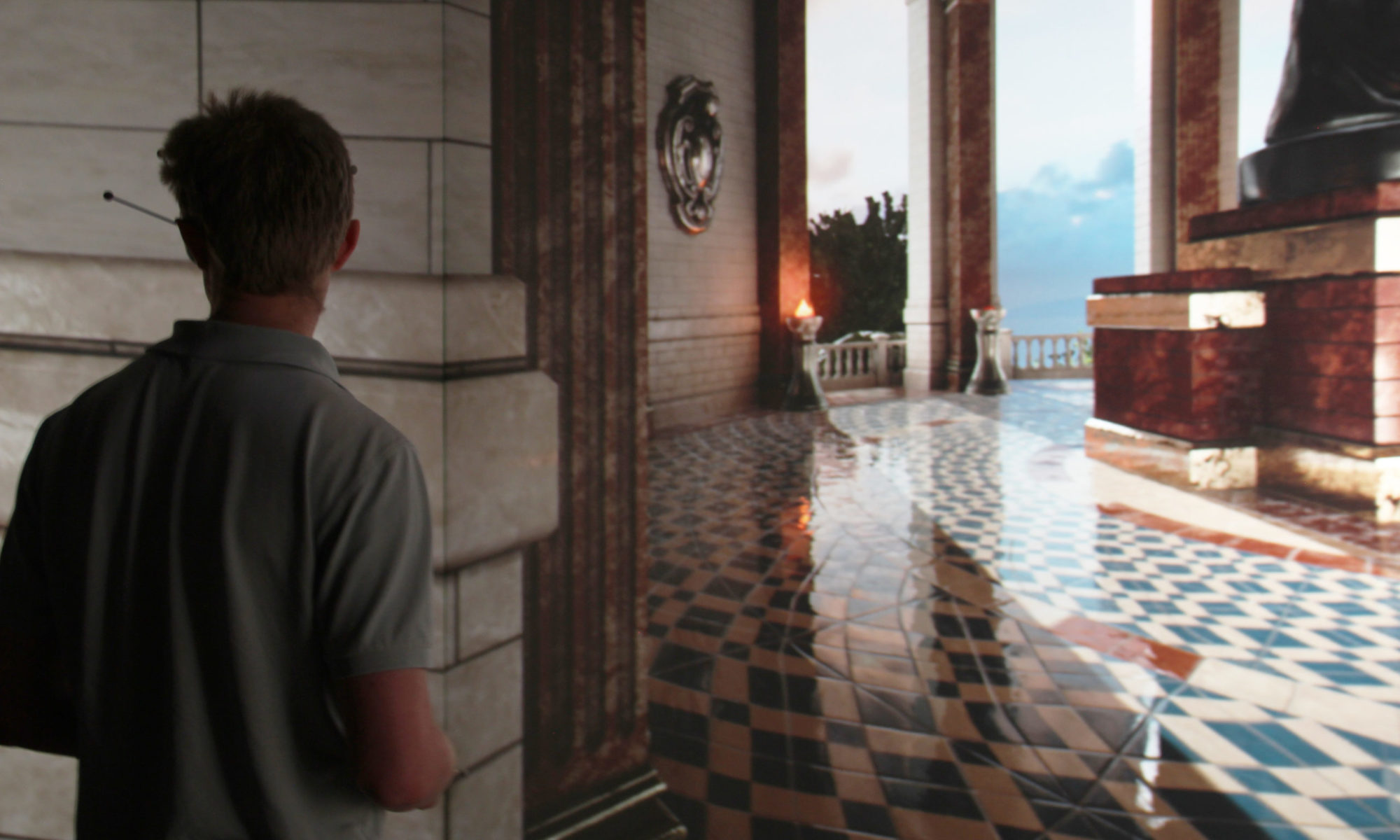Unreal Engine in Stereoscopic Virtual Reality
Visitors entering the MIDEN are equipped with a pair of stereo glasses and a game controller, both outfitted with reflective markers that are then tracked by a series of Vicon cameras positioned around the top perimeter of the space. The existing capabilities of the MIDEN allow viewers to not only explore a space beyond the confines of the 10’x10′ room, but to also interact with objects using the provided game controller.
 The services of the Duderstadt Center are open to all departments within the University, making visualization services, professional studio spaces, and exploratory technology accessible to artists, engineers, architects and more. The diverse atmosphere of the Digital Media Commons generates a multitude of cross-curricular collaborative projects each year – From live performances featuring orchestras manipulated via brain waves to exploring the anatomy of a digital cadaver in virtual reality.
The services of the Duderstadt Center are open to all departments within the University, making visualization services, professional studio spaces, and exploratory technology accessible to artists, engineers, architects and more. The diverse atmosphere of the Digital Media Commons generates a multitude of cross-curricular collaborative projects each year – From live performances featuring orchestras manipulated via brain waves to exploring the anatomy of a digital cadaver in virtual reality.
In the past the Duderstadt Center’s MIDEN has been used to prototype architectural spaces, host artistic installations and assess human behavior or simulate training scenarios. Incorporating the Unreal Engine into a space like the MIDEN allows visitors to experience an intense level of realism never before achieved in this sort of environment, opening new doors not just for gamers, but for those seeking high quality visualizations for research and exploration. Unreal Engine brings a wide range of materials and visual effects to any scene. From realistic water, foliage or glass, to effects like fire and transitions in the time of day.
Sean Petty, graphics programmer of the Duderstadt Center, explains his process for getting Unreal to operate from within the MIDEN:
The MIDEN requires us to render a different view of the scene to each of the four walls from the perspective of the user. In order to achieve this we must track the location and orientation of the users eyes, which is accomplished by motion tracking a pair of glasses worn by the user. In the MIDEN there is a dedicated computer performing the necessary calculations, the first step to enabling MIDEN support in Unreal is to modify the engine to interface with this computer.

Once the location of the user has been determined we must project the user’s view to each of the four walls. When rendering a scene in a standard desktop environment the camera is positioned in the center of the screen. A centered camera only requires a symmetric frustum projection which is the native transformation supported by Unreal. In the MIDEN, the center of the camera may be anywhere within the space and will often not be centered on a screen. This requires the use of an asymmetric frustum projection, which is functionality that had to be added to the engine.

Unreal has native support for stereo by rendering the left and right views next to each other into the single image. This setup is used for devices such as the Oculus rift where the both images for the left and right eye are displayed at the same time. The MIDEN uses a technology called “active stereo”, where the displayed image flickers back and forth rapidly between the left and right images. This requires a modification to the engine so the left and right images are rendered to two separate buffers rather than to two sides of a single image.

The final step for displaying unreal scenes in the MIDEN is to get the four rendering computers communicating with each other. This ensures that when the user moves all the screens are updated appropriately to give a consistent view of the scene. The networking is accomplished using Unreal‘s built in network replication functionality, which is designed for use in multiplayer games.
With this latest development, researchers across all disciplines are now able to utilize this technology to reproduce lifelike environments for their studies giving subjects the ultimate immersive experience. It is hoped that this higher level of immersion offered by the Unreal Engine will have a dramatic impact in studies involving human behavior and environmental effects.
In addition to incorporating Unreal, the MIDEN also continues to operate using an in-house engine developed by Ted Hall & Sean Petty, called “Jugular,” which provides support for a broad range of models, materials, and interactivity. While Unreal offers finer elements of photo-realism for mesh-based geometry, Jugular supports easier import of a wider range of file types from a variety of sources, including not only meshes but also solid volumes and informatics graphs.





